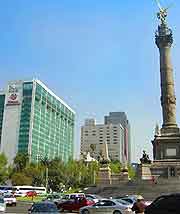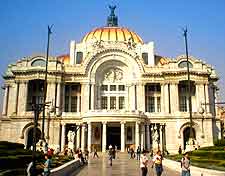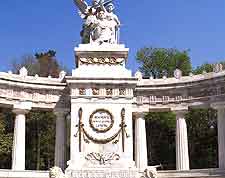Mexico City History Facts and Timeline
(Mexico City, Federal District, Mexico)

A massive city known as the 'Place of the Gods', or Teotihuacán, was the first settlement to establish itself where Mexico's modern capital city stands today. Teotihuacán's population topped 100,000 before this ancient city was abandoned for unknown reasons around the year 750 AD.
Although many medium-sized communities were established around Lake Texcoco during the following centuries, none could rival the size of Tenochtitlán, the sprawling Aztec Empire capital founded in 1325. When Spanish conquistador Hernán Cortés first laid eyes on Tenochtitlán in 1519, he encountered a sophisticated city whose population of over 100,000 was larger than that of many European cities at the time. Looking at modern day Mexico City, it's difficult to imagine this history, and certainly you need to take a guided tour to the remaining excavations outside of the centre to appreciate this fact.
Spanish Conquest
Tenochtitlán's emperor, Moctezuma II, welcomed the conquistador into his city, because he believed Cortés was a returning and revered Aztec god called Quetzalcóatl. The Spaniards quickly took control and made Moctezuma II their prisoner. He died in 1520 and was followed by Cuauhtémoc, the Aztec ruler who led his people in the valiant defence of the city from Spanish rule. But it was the beginning of the end for the native population, and he was eventually tortured and executed.
After the Spaniards defeated the Tenochtitláns in 1521, Cortés ousted the remaining Aztecs from Tenochtitlán and razed what was left of their former capital. A new city called Mexico was established as New Spain's capital on the boundaries in 1522. Spanish nobility moved into former Aztec palaces, while Catholic churches were constructed on top of ancient Aztec temples. Many of these magnificent churches and palaces still stand in Mexico City today.

History of Mexican Independence
After a decade-long war, Mexico gained independence from
Spain and Mexico City became the new republic's capital in 1823. The city survived American and French invasions during the mid-19th century, and the Paseo de la Reforma promenade was constructed during Ferdinand Maximilian of Hapsburg's brief rule. The Palacio Postal and the Palacio de Bella Artes are just two of the numerous European-style structures built in the late 19th century.
Mexico City in the 20th Century
Commemorating the War of Independence is Mexico City's golden Angel of Independence, a victory monument found on the wide and elegant avenue of the Paseo de la Reforma, which was modelled by the order of Emperor Maximilian of Mexico after the Champs-Élysées in
Paris. The Angel of Independence was erected in 1910, a century after Mexico's independence and the same year as the Mexican Revolution

Two of Mexico City's proudest 20th-century moments were the 1968 Olympic Games and the 1970 Football World Cup. The one constant in Mexico City's 20th Century was the Institutional Revolutionary Party (PRI), which ruled both the city and the nation from 1929 to 1997. It oversaw a massive expansion of the city to become one of the world's most populated, not to mention congested, being plagued by kidnappings.
Modern Mexico City
Mexico City is now starting to overcome its decades-long reputation as a city filled with crime, pollution and shantytowns, regaining its past glory. The city is now the world's eighth richest and the Western Hemisphere's second-most populated. The Castle of Chapultepec houses the National Museum of Anthropology, just one of Mexico City's 100+ museums, which makes it host to more museums than any other city on earth.
 A massive city known as the 'Place of the Gods', or Teotihuacán, was the first settlement to establish itself where Mexico's modern capital city stands today. Teotihuacán's population topped 100,000 before this ancient city was abandoned for unknown reasons around the year 750 AD.
A massive city known as the 'Place of the Gods', or Teotihuacán, was the first settlement to establish itself where Mexico's modern capital city stands today. Teotihuacán's population topped 100,000 before this ancient city was abandoned for unknown reasons around the year 750 AD.
 Two of Mexico City's proudest 20th-century moments were the 1968 Olympic Games and the 1970 Football World Cup. The one constant in Mexico City's 20th Century was the Institutional Revolutionary Party (PRI), which ruled both the city and the nation from 1929 to 1997. It oversaw a massive expansion of the city to become one of the world's most populated, not to mention congested, being plagued by kidnappings.
Two of Mexico City's proudest 20th-century moments were the 1968 Olympic Games and the 1970 Football World Cup. The one constant in Mexico City's 20th Century was the Institutional Revolutionary Party (PRI), which ruled both the city and the nation from 1929 to 1997. It oversaw a massive expansion of the city to become one of the world's most populated, not to mention congested, being plagued by kidnappings.